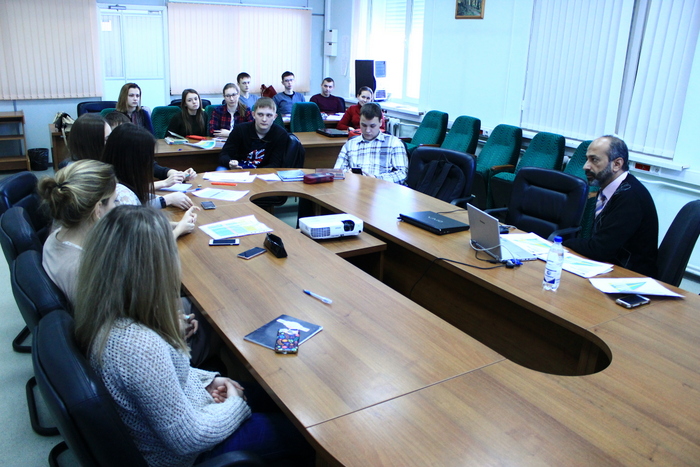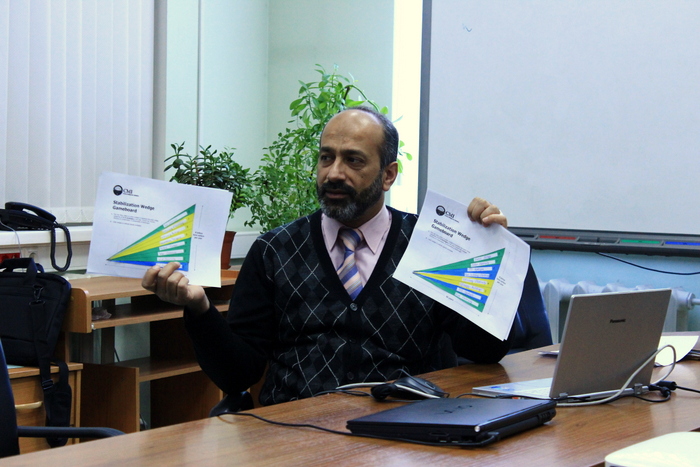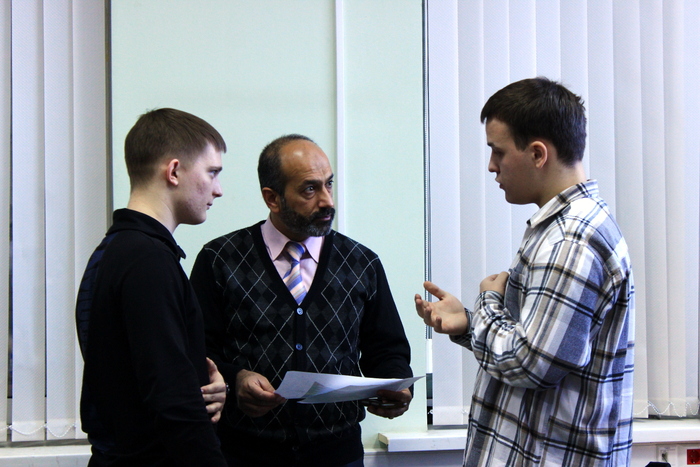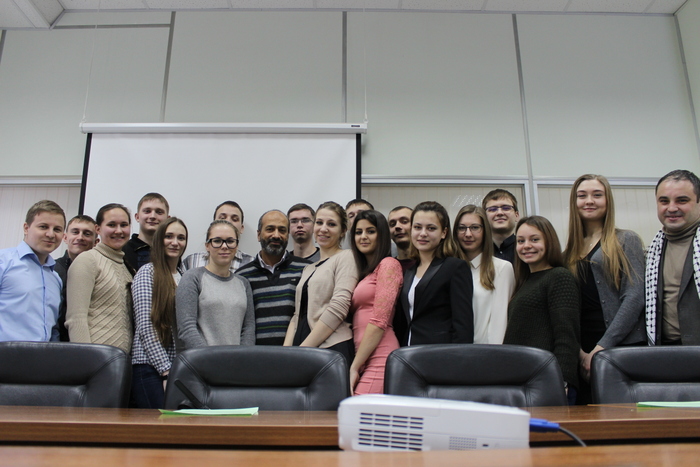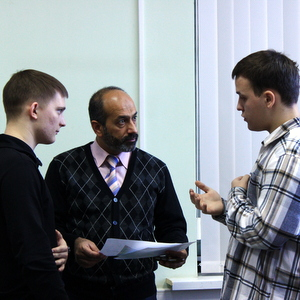Japan is among top ten leading countries, manufacturers of alternative energy. Some 11% of all energy in Japan comes from renewable sources; by 2030 the goal is to increase the share to 24%. Professor Yaser Qudaih of the Kyushu Institute of Technology came to Samara University from the Land of the Rising Sun.
On December 20-23, he presented a series of lectures on energy-saving technologies for undergraduate and graduate students of the Institute of Engine and Power Plant Engineering, and negotiated joint research projects with Samara National Research University. The professor told the students about the effective systems of obtaining energy, using energy-saving technologies in everyday life and the future of this field.
Between the lectures Dr. Qudaih talked to reporters of Samara University Youth Information Agency about renewable energy sources, green technologies and cooperation opportunities between Samara University and Kyushu University of Technology.
Q: Are energy-saving technologies the future of the humankind?
A: In Japan we believed in green technologies several decades ago. The consequences of the Fukushima earthquake confirmed the fact that such technologies represent the safest, most optimal and correct approach.
The climate is changing, global warming is having some profound impacts. All these issues and challenges force us to start thinking about new electricity-producing technologies with the help of environmentally-friendly resources.
We are working on studies of how we live in our homes, we combine smart homes into communities. The main thing in these technologies is optimization. We need to optimize resources and needs to improve people’s lives.
Q: How can energy-saving technologies influence the lives of ordinary people?
A: To have an influence on people’s lives we need three components.
The first, of course, is education. We must start teaching about energy technologies and using them correctly at all levels, from the elementary school to the university. In Japan young children start these lessons in the very first grade. Elementary school students learn about the energy of wind, how to make “eco-friendly” energy, for instance, from lemons or potatoes. I should think such courses will soon appear in Russia, too. This “energy literacy” is a new, eco-friendly way of working with electricity.
The second component is the aspiration to use daily consumption products rationally and in an eco-friendly way
Finally, the third component is infrastructure that can be adapted to eco-friendly technologies.
Q: What are the advantages of “eco-friendly” technologies for the state?
A: In the economy they create new opportunities for business. The environmental benefit is that they will create solutions for some ecological problems.
We need to understand that this is a global issue and several states, even if they are well-developed, will not be able to solve this problem. We live in the same big “home.” If something happens to the environment in Russia, it will affect Japan and the US as well. So if some countries appear not to be able to solve new “clean” energy methods, other countries will help them. The UN is working on coordinating these issues. Many organizations and universities worldwide are solving problems of lowering expenses for new energy, trying to make it as cheap as coal, for instance. In Japan they counted the number of sunny days and the amount of solar energy the country receives a year, and it became obvious that it is very beneficial to use solar batteries. These processes are taking place all over the world. I visited some quite poor countries where the governments are planning to install solar panels, because these technologies are quite profitable for their climatic conditions.
Q: Which energy-saving technologies at this time are most effective for solving economic, ecological and social problems?
A: I think that the most effective are eco-friendly homes. The way of building homes must be changed; they must be made more independent from electricity. It is important to note things that many people have been initially overlooking. Such as, for instance, which side the windows face. We use energy-saving materials in the glass to use the solar energy to the maximum.
New buildings must be built of materials that conserve the energy in the best possible way. There exist such eco-friendly homes in Japan today. For instance, if plants, such as yam, grow on the wall, large leaves will protect your home from the sun. Green walls made of yam vines help air conditioners consume less electricity.
Air conditioners themselves must be of high energy-saving class. Especially in production.
Make note, for instance, how we use such things as heaters. When we leave, the heater remains on. This energy is wasted.
And now think of how we eat. People throw away too much food! How can it be reprocessed?
All these issues require teaching people about using eco-friendly technologies in everyday life, and decision-makers in various productions and industries.
Q: Changing the society’s attitudes to energy-saving appears to be a fairly complicated process. Can you tell us about optimal, least expensive ways of changing these attitudes?
A: This is not very difficult if the government creates new standards in the sphere of energy and construction. You do not have to change what exists today, you just need to start building new houses according to new projects. Therefore, the standards will change the situation drastically and in the future our society will be energy efficient. Changing the old infrastructure is possible but it will take a lot of time. The time it will take depends on how much people themselves want changes. In some societies it will take five years, in others - a century. But the best option is to start using new standards. Now we have precise measuring equipment, we know what the weather will be tomorrow and what will happen next year. We can do forecasting. First we need to build the new “eco-friendly” infrastructure and then work on reorganizing the existing old infrastructure. This must be done in cooperation with the entire society, scholars and the government.
Q: What three to five inexpensive technologies can help improve the quality of the city’s energy-saving system?
A: First technology is installation of solar batteries. It is relatively inexpensive and it will be effective in Russia even with the snow. There are solutions to this problem today.
The second technology is planting “green walls,” more greenery. People need to understand that they must grow plants on their balconies, for example. They will create shadows and it will help save electricity for air conditioning.
The third technology are energy-saving lamps. They are inexpensive, easy to use and will allow to save energy.
And fourthly, education. People need to learn to use the tools of energy-saving consumption. You can start from elementary school. Children need to learn to turn off the light when they leave a room, learn to use the sun to consume less electricity.
Q: Please tell us about Smart Cities in Japan.
A: There are so called “smart communities” in several Japanese cities. For instance, in the city of Kitakyushu. I participated in many projects within the Smart City program. We live in special energy-saving homes, we have a special energy management center, very advanced electric meters that record the quantity of consumed energy, electric cars. This is an experimental community, and residents are required to share their impressions regularly. As of right now, everything is fine, the experiment is proceeding smoothly, people like it, and less power is consumed.
The initiative in the Smart City program comes from the Japanese Government. But now people in Japan started joining Smart communities on their own accord. This was where the private business sector joined in because they too are interested in making profits from new technologies.
Q: Do developers share the technologies with all the participants in the experiment free of charge?
A: It depends. Some, like Nippon Steel, do. They send hydrogen generators to some homes. Nissan offers discounts for high-tech purchases, stimulating consumption. We also have a trade center that provides special discount vouchers for housewives so that they could come to the trade center to spend their time there at peak hours of electricity consumptions, such as hot summer days. This way we spend less money on air conditioning than if they all had stayed at home. They buy more discounted products, spend time in the trade center and spend less energy. Trade centers provide vouchers on their own accord, this is their marketing strategy.
Q: Is participating in the project of building a Smart City free of charge?
A: No. You do have to pay, but the payment is comparable to renting housing or buying an apartment in an ordinary building. People still get a choice of whether they want to use the “smart city” scheme or choose ordinary housing. For instance, should they want to use their air conditioning all day, this is entirely their choice, they can do it. They will have to pay a bit more than others, but in the future this will be recouped. They will be able to sell the surplus energy generated by solar batteries to the state. Overall, things are going well.
Q: Impressive! What are the potential directions for cooperation between Samara University and Kyushu Institute of Technology?
A: The last time the delegation of Samara University visited Kyushu, I showed them the satellite, and we signed the memorandum of understanding. This question is currently being actively debated. Exchange programs are being planned for students and scholars, as are symposia and summer school sessions. And, of course, we will be ready to take part in implementing research projects.
Q: You have spent several days in Samara already, what are your impressions of Samara University and City of Samara overall?
A: Samara is a quiet place. People are very kind. I feel very good here. Speaking about science and technology, I saw the museum of engines, and it is a remarkable place. Samara must be proud of having such a museum, this is very inspiring! I also like Russian food. I will be happy to come to you again.
Interviewed by Dmitry Gorokhov, Nikolay Rudenko, Samara University Youth Information Agency
